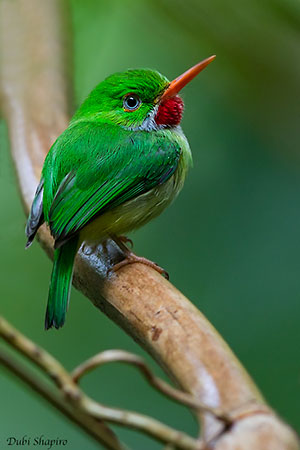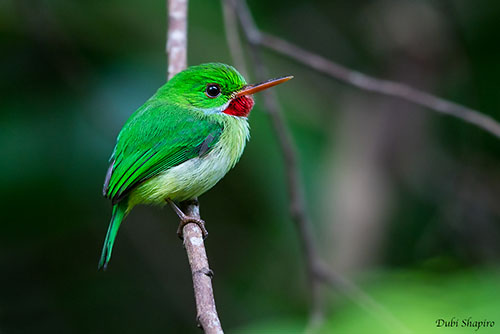
Fr: Todier de la Jamaïque
Ang: Jamaican Tody
All: Grüntodi
Esp: Barrancolí Jamaicano
Ita: Todo della Giamaica
Nd: Jamaicaanse Todie
Sd: jamaicatodi
Photographers:
Jean Michel Fenerole
Photos d’Oiseaux du monde
Ken Havard
My Bird Gallery & Flickr gallery 1 & Flickr gallery 2
William Price
PBase-tereksandpiper & Flickr William Price
Dubi Shapiro
Dubi Shapiro Photo Galleries
Text by Nicole Bouglouan
Sources:
HANDBOOK OF THE BIRDS OF THE WORLD Vol 6 by Josep del Hoyo-Andrew Elliott-Jordi Sargatal - Lynx Edicions, 2001 - ISBN: 848733430X
BIRDS OF THE WEST INDIES – by Herbert Raffaele, Kristin Williams et Tracy Pedersen – Helm – ISBN: 9780713649055
Neotropical Birds – Cornell Lab of Ornithology
Wikipedia, the free encyclopaedia
Jamaican Tody
Todus todus
Coraciiformes Order – Todidae Family
INTRODUCTION:
The Jamaican Tody is endemic to Jamaica where it frequents a variety of wet and arid forest. It is common and widespread from coasts to mountains.
It feeds on insects and small fruits found in the understorey. It typically nests in burrow excavated by the pair in earth bank or in rotten tree trunk, and a fresh tunnel is dug each year.
The Jamaican Tody is affected by predation by mongooses (Herpestes) and habitat destruction, but currently, the species is not globally threatened.

DESCRIPTION OF THE BIRD:
Biometrics:
Length: 9-11 cm
Weight: 5,5-7,2 g – F: 6,5 g
The Jamaican Tody is a tiny, chunky colourful bird.
It has bright green upperparts including head, wings and tail.
On the underparts, chin and throat are red. Breast sides are pale yellowish-green whereas belly is mostly yellow. There is some pink on flanks.
The head is green, with white moustachial stripe ending in small sub auricular blue-grey patch and joining the breast sides.
The two-tone bill has black upper mandible and red lower one. The eyes are white or pale blue-grey, with some red above and below on the eyering. Legs and feet are pink with black claws.
Male and female are similar but the female has less conspicuous sub auricular blue-grey patch.
The juvenile has dull green back, grey or pink throat, and the breast is washed grey to greenish. The young bird is duller overall.
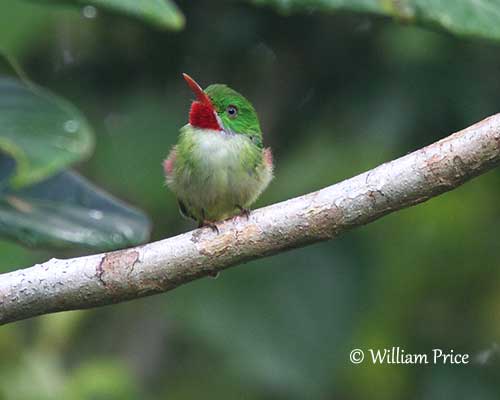
RANGE:
The Jamaican Tody is found in Jamaica.
HABITAT:
The Jamaican Tody frequents all forest types from wet to dry forests. It is mainly found in wooded hills and mountains, but its typical habitat may include mangroves and dry lowland forests. It is rarely seen above 1,500 metres of elevation.
From a study, it occurs at highest densities in areas with woodland patches and some open pastures, but it generally avoids the pine forest.
CALLS AND SONGS: SOUNDS BY XENO-CANTO
The Jamaican Tody is fairly silent outside of breeding season. It gives a loud “beep” in various situations, with different sharpness, intensity and frequency. We can also hear a rapid, guttural throat-rattling “frrup” used during the territorial displays. The alarm call is a loud hissing “cheep”.
The bird also produces a loud, whirring sound, a buzzing noise made by the wings during the flight, described as “wing-rattling”. This noise is caused by the air passing through the primary feathers. It is mainly heard during territorial and courtship displays.
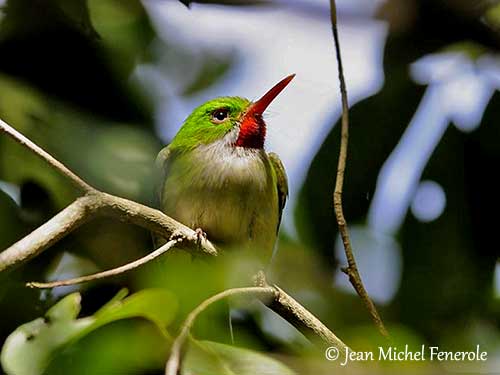
BEHAVIOUR IN THE WILD:
The Jamaican Tody feeds on a wide variety of insects including flies, beetles, grasshoppers, crickets and moths. Spiders, millipedes and small lizards, and occasionally fruit, are also part of the diet. It usually avoids stinging insects.
It forages by exploring the undersides of leaves, sallying up to catch a prey and then, moving to another perch. This behaviour is described as “underleaf-sally”.
It forages in the understorey, between 1 and 5 metres above the ground. Its very specialized foraging behaviour avoids direct competitions for food.
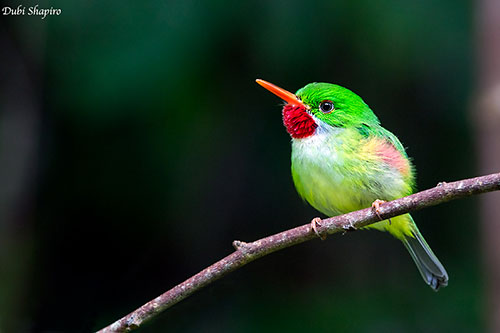
Todies are monogamous. Chases between mates are part of courtship displays, with strong “wing-rattling” and “wing-cracking”. They pursue each other among low foliage over distances of up to ten metres. The chases involve numerous body contacts and even tumbles.
Other displays show the perched bird hopping and bobbing rapidly while fluffing its plumage. The pink flanks are also displayed. Courtship feeding is observed after the chases, often with insects.
The female solicits the male by flapping her wings, then spreading them while raising her short tail. Copulation usually follows this display.
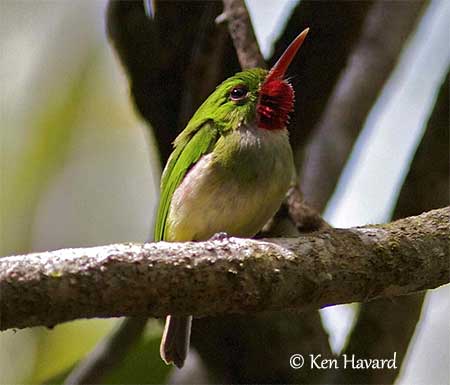
The Jamaican Tody is sedentary and remains in its territory year round. The pair reuses the same site in several following years.
This species has short, rounded wings, in accord with short-distance flights and small territories.
REPRODUCTION OF THIS SPECIES:
The breeding season takes place between December and July.
Both adults excavate the burrow in vertical earth bank or in rotten tree trunk. The nest chamber is at the end of the tunnel.
The burrow is usually about 1-3 metres above the ground. The birds use both bill and feet to dig it, and male and female work alternately while giving low sounds as contact calls between them. The pair defends strongly the nesting site.
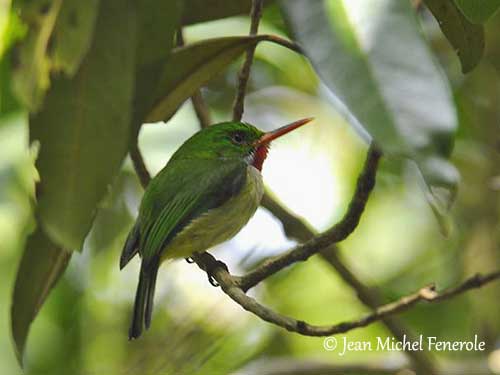
The female lays 1-4 white eggs and both adults incubate during about three weeks. The chicks are altricial and naked. They are fed with a large amount of insects.
Prior to fledging, the adults utter “beep” calls at nest entrance to attract the young outside of the burrow. The fledglings remain within 25 metres from the nest during the first five weeks, but they do not return to the nest. They are still fed for three weeks after leaving the burrow.
PROTECTION / THREATS / STATUS:
The Jamaican Tody has restricted range but it is common. It is affected by predation by mongooses (Herpestes), hunting by rural children and mainly by habitat destruction.
This species is usually widespread from coasts to mountains, and it is not globally threatened.
The Jamaican Tody is currently evaluated as Least Concern.
